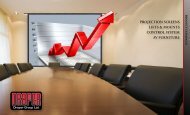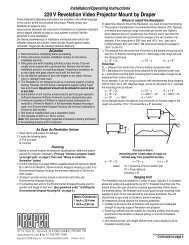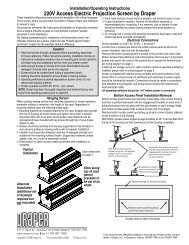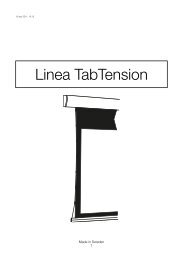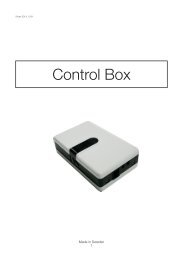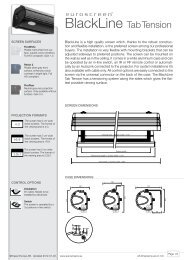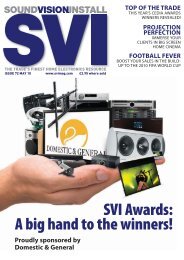Draper's Product Guide for Visual Communication - Draper Group Ltd
Draper's Product Guide for Visual Communication - Draper Group Ltd
Draper's Product Guide for Visual Communication - Draper Group Ltd
You also want an ePaper? Increase the reach of your titles
YUMPU automatically turns print PDFs into web optimized ePapers that Google loves.
Selecting a Projection Screen<br />
Textile Backed Screen Surfaces<br />
A reflective surface laminated to a woven textile base. The screen surface hangs suitably<br />
flat because of the stability of the material and the weight of the bottom dowel. Good <strong>for</strong><br />
all types of projection.<br />
Matt White—Diffuses projected light in all directions, so image can be seen<br />
from any angle. Has accurate color rendition and superior clarity. Requires<br />
control of ambient light in the audience area. Washable, flame and mildew resistant.<br />
Glass Beaded—Spherical glass beads embedded in surface provide brighter<br />
on-axis viewing than Matt White, within a narrower viewing cone. Glass Beaded<br />
surfaces have some loss of clarity and per<strong>for</strong>m best with table-mounted projectors.<br />
Flame and mildew resistant. Cannot be cleaned. Seamless in standard sizes through<br />
10´ high.<br />
High Contrast Grey—Grey surface offers excellent resolution while<br />
enhancing blacks, even as whites and lighter colors are maintained. Per<strong>for</strong>ms<br />
well in ambient light. Lower gain of 0.8 allows use with even the brightest projectors.<br />
Seamless in sizes up to 8´ in height.<br />
AT1200 and AT Grey—Similar in gain per<strong>for</strong>mance to Matt White, with acoustical<br />
properties comparable to the finest speaker grille cloth. Washable, flame and<br />
mildew resistant. Available in sizes through 7˝ x 6˝ or 10´ NTSC diagonal. AT1200<br />
is white; AT Grey is grey <strong>for</strong> high contrast. Acoustically transparent fabrics are<br />
not recommended <strong>for</strong> screens smaller than 80˝ wide when used with LCD or DLP<br />
projectors.<br />
Tensioned Screen Surfaces<br />
These screen surfaces are tensioned vinyl with no textile backing. <strong>Draper</strong> offers<br />
motorized, crank-operated and permanently tensioned screens with built-in tensioning<br />
systems. Advantage—The surface is stretched perfectly flat, resulting in better picture<br />
quality. Highly recommended <strong>for</strong> video or data-graphics projection.<br />
M1300—The perfect Matt White diffusing surface. For use with any type of<br />
projector in rooms where light can be reasonably controlled. Washable.<br />
M2500—A high-contrast front viewing surface with excellent resolution and high<br />
gain. M2500 tolerates a higher ambient light level than most other front projection<br />
screen surfaces.<br />
HiDef Grey—A grey front projection surface that provides excellent contrast<br />
and black reproduction with a low gain to handle today’s super-bright<br />
projectors. Enhances color contrast, black levels and allows <strong>for</strong> more<br />
ambient light.<br />
Cineflex—A neutral grey vinyl <strong>for</strong> rear projection. Cineflex has high resolution<br />
and excellent contrast, even in lighted rooms. For use with any type of projection<br />
equipment. Lower Gain version of Cineflex is also available with peak gain of 0.8.<br />
Matt White & AT1200<br />
Gain 3.0<br />
2.0<br />
1.0<br />
0.5<br />
Glass Beaded<br />
Gain 3.0<br />
Gain 3.0<br />
2.0<br />
1.0<br />
0.5<br />
M1300<br />
Gain 3.0<br />
2.0<br />
1.0<br />
0.5<br />
M2500<br />
Gain 3.0<br />
2.0<br />
1.0<br />
0.5<br />
Gain 3.0<br />
2.0<br />
1.0<br />
0.5<br />
HiDef Grey<br />
2.0<br />
1.0<br />
0.5<br />
Cineflex<br />
Gain Charts<br />
70° 50° 30° 10° 10° 30° 50° 70°<br />
Viewing Angle<br />
50° 30° 10° 10° 30° 50°<br />
Viewing Angle<br />
High Contrast Grey & AT Grey<br />
70° 50° 30° 10° 10° 30° 50° 70°<br />
Viewing Angle<br />
70° 50° 30° 10° 10° 30° 50° 70°<br />
Viewing Angle<br />
50° 30° 10° 10° 30° 50°<br />
Viewing Angle<br />
70° 50° 30° 10° 10° 30° 50° 70°<br />
Viewing Angle<br />
Gain 3.0 Gain 3.0<br />
2.0 2.0<br />
1.0 1.0<br />
0.5 0.5<br />
70° 50°<br />
30° 10°<br />
10°<br />
30° 30° 50° 50° 70°<br />
Viewing Angle<br />
Surface Selection Factors<br />
Gain—a relative measure of a screen’s reflectivity. Charts (shown above) depict gain values (reflectivity) at various points, measured in<br />
degrees from projection axis. These charts help judge uni<strong>for</strong>mity. The flatter the curve in the portion of the viewing cone where viewers<br />
sit, the more consistent the image they will perceive. The quality of the image we perceive is primarily a function of gain, contrast,<br />
uni<strong>for</strong>mity and resolution.<br />
Contrast—the ability to accurately reproduce and differentiate light and dark colors.<br />
Ambient light rejection properties—the ability to per<strong>for</strong>m well under normal to adverse audience lighting conditions.<br />
Resolution—the clarity of the projected image.<br />
Uni<strong>for</strong>mity—the screen’s per<strong>for</strong>mance when viewed from points off the projection axis (horizontally or vertically), and when the<br />
brightness of the center of the image is compared to the corners.<br />
4<br />
www.draperinc.com | 1-800-238-7999



